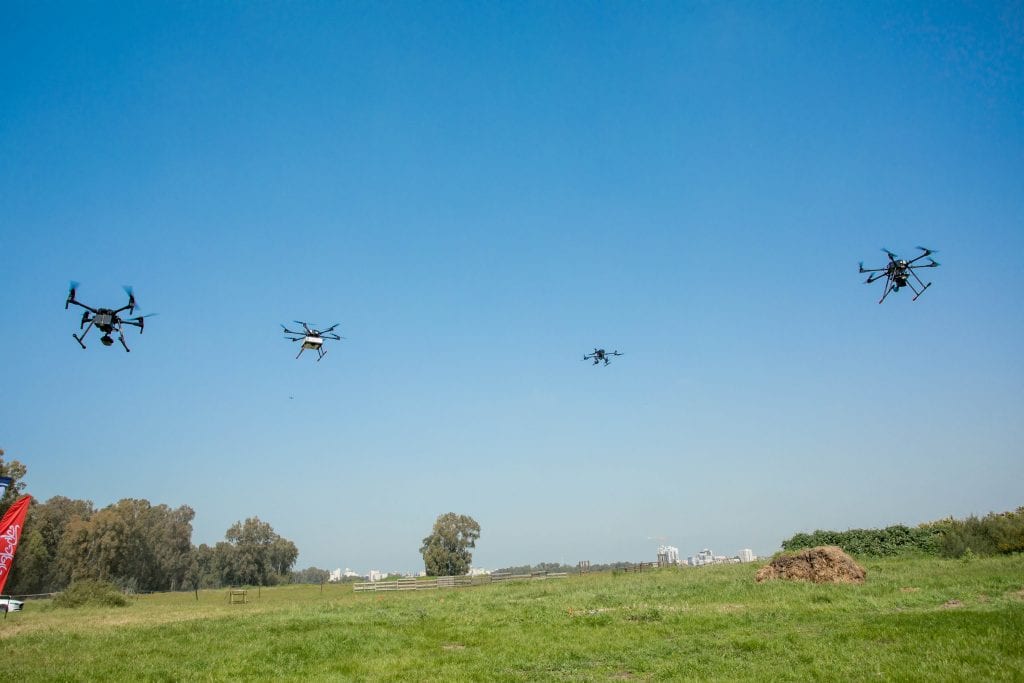
The project includes five UAS companies that are operating their own drone fleets within this corridor. The drones use their own UAS service systems (USS) to do route planning and flying. Those USS systems are what communicate with Airwayz’ UTM system. (Airwayz)
The future of drone operations could include thousands of drones operating within an airspace corridor all communicating through a traffic management system. The first step to turning this idea into a reality is currently underway in Israel where five unmanned aircraft system (UAS) companies are operating their fleets within a corridor being managed by an unmanned traffic management (UTM) system operated by Airwayz.
“Drone delivery has the potential to dramatically increase the safety, speed and efficiency of transport systems across the globe,” Eyal Zor, CEO and Co-Founder of Airwayz, said in a statement. “However, so far, we’ve only seen these types of pilot schemes test drones moving back and forth across a corridor of airspace. This restricts the number of drones that can work in an area and risks whole operations being abandoned if any part of the corridor becomes inoperable mid-mission. This way of working in corridors is simply not practical for the technology to scale-up for commercial use. This pilot scheme will demonstrate how drones can operate in a mesh, reacting safely to real-time situations, whilst also maximizing delivery efficiency for a commercially viable solution to drone delivery.”
The project includes five UAS companies that are operating their own drone fleets within this corridor. The drones use their own UAS service systems (USS) to do route planning and flying. Those USS systems are what communicate with Airwayz’ UTM system.

The UTM has access to a lot more information than the USS like weather and nonflight zones, Serok said. Once the UTM receives a request from the USS, it begins sorting that information in order to approve or disapprove of the flight plan. (Airwayz)
Tomer Serok, a director at Airwayz, explained to Aviation Today how these systems would work in an example scenario of using drones to deliver food.
“The process should be that as soon as you key it in or you got it from your mobile phone and its gone to the USS, and the USS says okay from point A to point B, which is your house, given the information I got from the UTM that…I’m planning that route,” Serok said. “And then it transmits that request to the UTM and the UTM will either approve or disapprove.”
The UTM has access to a lot more information than the USS like weather and non-flight zones, Serok said. Once the UTM receives a request from the USS, it begins sorting that information in order to approve or disapprove of the flight plan. To do this it uses artificial intelligence (AI).
“Basically, the UTM replaces the software of the ATM, the air traffic management, the one you have in the control tower, but also the men in the control tower so the decision making is done by the UTM as well,” Serok said. “The USS is requesting a certain flight path from the UTM, the UTM is checking that comparing it with an offline zone, with weather conditions, with the capability of the drone itself because it could be multiple drones, and if there’s any conflict with other USS.”
This is all down pre-flight. While humans can be in the loop at the USS level, Serok said they cannot at the UTM level because there is just not enough time to account for human decision timelines.
“Without artificial intelligence, this thing will not work,” Serok said. “The drones will never be able to deliver you burgers, pizzas, do an inspection, police work, firework, in a city. It’s not going to happen. If you just got to do it manually, which means you have to predefined corridors for drones for the operator, you might get to 10 percent or five percent of the capabilities, but you will never even get close to the potential of the drones. You cannot do drone deliveries because if you’re doing everything very rigid there’s no way you can squeeze all these things into the sky.”
The tests conducted in this project are allowing Airwayz to test and improve its AI-based system. During one of these tests they had a manually flow drone try to crash into a drone flying within their system, Serok said. The drone was able to avoid the collision and then go back to the originally planned route.
The government requested that the project test the GPS accuracy of the drones to help decide what the required distance should be between them when flying in the airspace, Serok said. The project was well suited to complete tests on this because of its inclusion of multiple drone companies.
“They decided that if it’s two drones, from two different USS, from two different companies that the shortest distance, the system will allow them to be in 60 meters, every direction doesn’t matter,” Serok said. “When it’s the same USS it allows 30 meters and not less than that.”
Government and regulatory agencies have yet to decide protocols or certification standards for AI within operations. This project will create data that can inform that decision-making process.
“Operating drones in a managed urban airspace is one of the most significant challenges prior to establishing regulation and integration of autonomous drones in Israel’s airspace,” Dr. Ami Applebaum, chairman of the Israel innovation authority and chief scientist at the Israeli Ministry of economy and industry, said in a statement. “Implementation of this pilot program, while demonstrating the operation of various drones by a number of different operators in the same airspace, marks the beginning of a new age in Israel’s smart transportation.”
Serok said Airwayz system has completed over 1,500 flights which have given it data and statistics to improve the algorithms used by its AI.